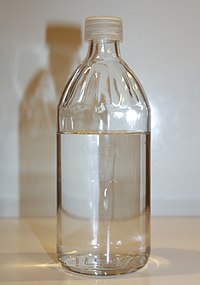
Photo from wikipedia
Nowadays, the interest in manufacturing non-alcoholic or low alcoholic content beverages from alcoholic beverages is a current challenge for food technologists; this is due to the fact that huge consumption… Click to show full abstract
Nowadays, the interest in manufacturing non-alcoholic or low alcoholic content beverages from alcoholic beverages is a current challenge for food technologists; this is due to the fact that huge consumption of alcoholic beverages may produce health problems in the costumers. In principle, the post-fermentation ethanol removal from alcoholic beverages is carried out by means of evaporation or distillation. Such current dealcoholization methodologies are efficiently removing the ethanol, however, some organoleptic compounds can also be lost during the process. This makes the dealcoholization process highly sensitive in order to preserve the quality properties of the beverages. Thereby, membrane-based technologies, which use perm-selective barriers for the separation, have been highly promoted for such purpose. Pervaporation (PV) technology is indeed one of these technologies aimed for ethanol removal. Herein, the goal of this review is to provide a compelling overview of the most relevant findings for the production of non-alcoholic beverages (such as beer and wine) by means of PV. Particular attention is paid to experimental results which provide compelling feedback about the accurate ethanol removal and minimal changes on physicochemical properties of the beverages. Moreover, some theoretical basis of such technology, as well as key criteria for a more efficient dealcoholization, are also given.
Journal Title: Journal of Food Science and Technology
Year Published: 2019
Link to full text (if available)
Share on Social Media: Sign Up to like & get
recommendations!